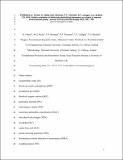Holistic evaluation of field-scale denitrifying bioreactors as a basis to improve environmental quality.
Date
2015-10-02Author
Healy, Mark G.
Metadata
Show full item recordUsage
This item's downloads: 264 (view details)
Cited 15 times in Scopus (view citations)
Recommended Citation
Fenton, O., Healy, M.G., Brennan, F.P., Thornton, S.F., Lanigan, G.J., Ibrahim, T.G. (2016) 'Holistic evaluation of field-scale denitrifying bioreactors as a basis to improve environmental quality'. Journal Of Environmental Quality, 45 (3):788-795.
Published Version
Abstract
Denitrifying bioreactors effectively convert nitrate-nitrogen (NO3-N) to di-nitrogen and thereby protect water quality in agricultural landscapes. In the present study, the performance of a pilot-scale bioreactor (50 m long, 5 m wide and 2 m deep) containing seven alternating cells, filled with either sandy loam soil or lodgepole pine woodchip, and with a novel zig-zag flow pattern, was investigated. The influent water had an average NO3-N concentration of 25 mg L-1. The performance of the bioreactor was evaluated in two scenarios. In scenario 1, only NO3-N removal was evaluated, whereas in scenario 2, NO3-N removal, ammonium-N (NH4-N) and dissolved reactive phosphorus (DRP) generation was considered. These data were used to generate a sustainability index (SI) a number which evaluated the overall performance taking these parameters into account. When the bioreactor performance was evaluated in scenario 1, it was a net reducer of contaminants, but it transformed into a net producer of contaminants in scenario 2. Inquisition of the data using these scenarios meant that an optimum bioreactor design could be identified. This would involve the reduction of the filter length such that it comprised only two cells a single sandy loam soil cell, followed by a woodchip cell, which would remove NO3-N, reduce greenhouse gas (GHG) emissions and DRP losses. An additional post-bed chamber containing media to eliminate NH4-N may be added to this bioreactor. Scenario modelling such as that proposed in this paper, should ideally include GHG in the SI, but as different countries have different emission targets, future work should concentrate on the development of geographically appropriate weightings to facilitate the incorporation of GHG into a SI.
Description
Journal article


